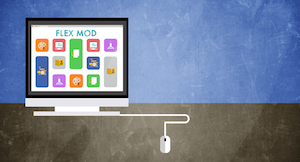
Interdisciplinary learning is gaining steam.
The good news is, integrating elements of STEAM doesn’t have to involve a complete schedule change or a curriculum overhaul. Here’s a look at 5 interdisciplinary topics you could incorporate into current classes that include a focus on science, technology, engineering, art, or math.
To get started, here’s a refresher on interdisciplinary learning.
Benefits of Interdisciplinary Learning
A variety of benefits are associated with interdisciplinary learning. Since subjects are interwoven, it’s easier for students to learn material in depth; their studies do not have to be fragmented between classes. The world itself is multidisciplinary – there are no clear-cut divisions, so students learn to assess problems the same way they’ll need to in college and their careers. This multi-faceted subject approach also helps both students and teachers focus on the “big ideas,” rather than getting stuck on little details. In addition to students’ heightened enthusiasm, schools that implement interdisciplinary programs also reap measurable benefits, such as increased attendance and improved standardized test scores.When combined with the hands-on nature of science, technology, engineering, arts, and math (STEAM), an interdisciplinary approach can yield engaged students ready to creatively tackle challenges, a mindset that will help them well beyond graduation.
Interdisciplinary Learning Ideas
By getting creative, you can merge interdisciplinary learning into your current curriculum via thematic units and project-based learning. Here are 5 topics that lend themselves to some surprising subject crossovers.
Area Guidebook
A perfect way to demonstrate the value of what students are studying is by asking them to pass along what they learn. In San Diego, students at High Tech High worked together to create a 246-page guidebook. They dove into the biodiversity of the area’s intertidal zones and harbors (science), compared early maps to those made with GIS technology, studied the impact of the military and industries on the bay (engineering), and took photos to accompany their content (art).Even if your city is not on the map as a top tourist destination, your students can still offer their services to the local visitors’ bureau, taking photos, creating videos, and designing informational brochures. They could also write a book about the community that highlights its history, geography, and business success stories, then follow up production by tracking sales (math) and creating press kits. Or perhaps they could key in on an even smaller area: your school. Would a “welcome to our school” book or brochure be beneficial marketing material?
Olympics
There’s nothing better than a timely thematic unit to give real-world significance to your students’ studies. Next winter, why not go global with the Olympics? Teachers can kick-start the unit with the geography of Seoul, South Korea (science). They can incorporate the way technology and engineering shape athletics during training and competition, as well as their behind-the-scenes impact on site setup and broadcasting. Looking for ideas to give your educators about ways to sprinkle in art or math? Perhaps students could research competing countries and design travel brochures or graph the number of medals each country brings home.The American Civil War
The Civil War is not just for history class. In fact, it makes for a perfect STEAM theme! Students can explore the common illnesses and injuries of the war (science), as well as the telegraph, other communication tools, and the weapons used in battle (technology and engineering). Students considering joining the military will benefit from seeing how technologies have changed over time. Any class can incorporate art by asking students to sketch the battlefields, publish their own political cartoons, or study Matthew Brady’s wartime photography. This unit also opens the door to discussing inflation and calculating soldiers’ wages and the equivalent worth of civil war bounty today (math).Landmark Restoration Project
When a project-based learning endeavor benefits the community, students are never left to question, “why are we doing this?” Putnam Vocational Technical High School in Massachusetts took a community-centered approach to integrating elements of STEAM into its curriculum. Over the course of 5 years, students helped restore a historic carriage house built in 1885. The project included many elements of STEAM, as carpentry, electrical work, heating, air conditioning, drafting (science, technology, engineering, math), landscaping, and design (art) were all a part of the renovation. The carriage house now serves as a public space for meetings, receptions, and special events. Your community may not have a carriage house, but perhaps a different old building, a piece of art, or a broken-down machine could provide a perfect opportunity for students to link the history of your town to the technology of today.Currency
Students will need to consider finances their entire lives, yet it’s a topic that often doesn’t get much attention in schools. During a currency unit, students can learn about the metals used to create coins (science) and the process used to manufacture coins and bills (technology and engineering). They may enjoy researching the design process and can even design coins for their families or a country they’ve studied (art). Of course, incorporating math into this unit is simple. Beyond money-based word problems, a unit on currency provides the perfect opportunity to discuss GNP, GDP, and the amount of time and money printing and coining requires. A greater understanding of currency will help students grow in financial literacy and make better decisions.The incorporation of STEAM into your curriculum doesn’t have to be a complex proposition. Science, technology, engineering, art, and math can connect with almost any subject matter – not just those that bear their names. By exposing students early and often to these fields and demonstrating their real-world significance, your teachers will help prepare students to be interdisciplinary thinkers who are set up for success.
Keep the conversation going on Twitter with #STEAMchat and #STEMchat!
WHAT'S NEXT FOR YOUR EDTECH? The right combo of tools & support retains staff and serves students better. We'd love to help. Visit skyward.com/get-started to learn more.

|
Lauren Gilchrist Blogger, Traveler, and Video Talent |
Lauren enjoys visiting school districts and spreading the word about creative, non-traditional approaches to universal challenges. Follow her for on-the-scene education journalism (with a little fun sprinkled in).




